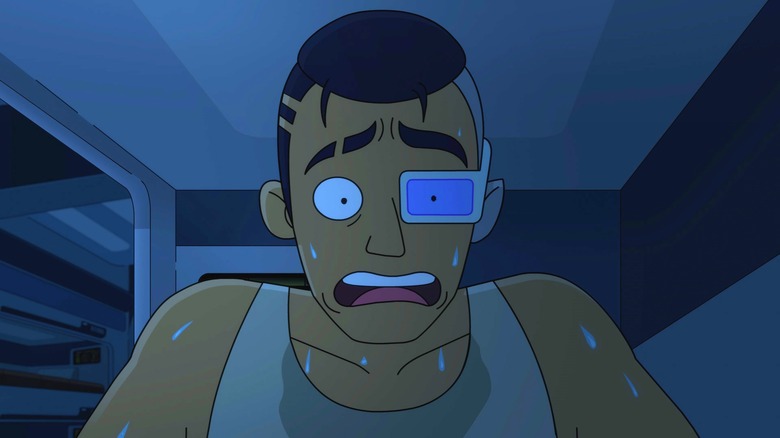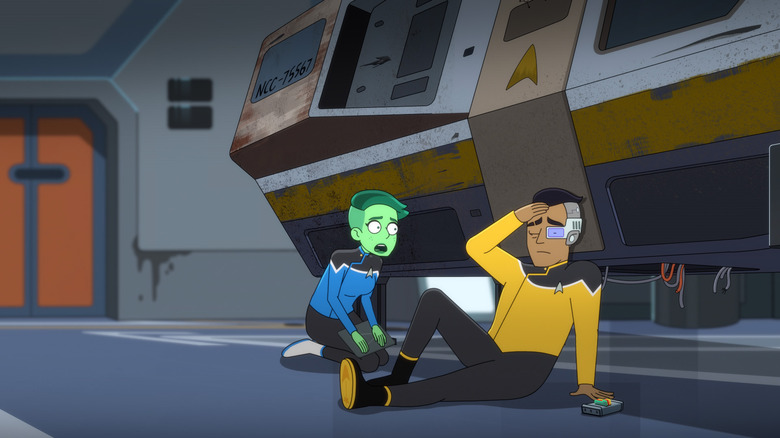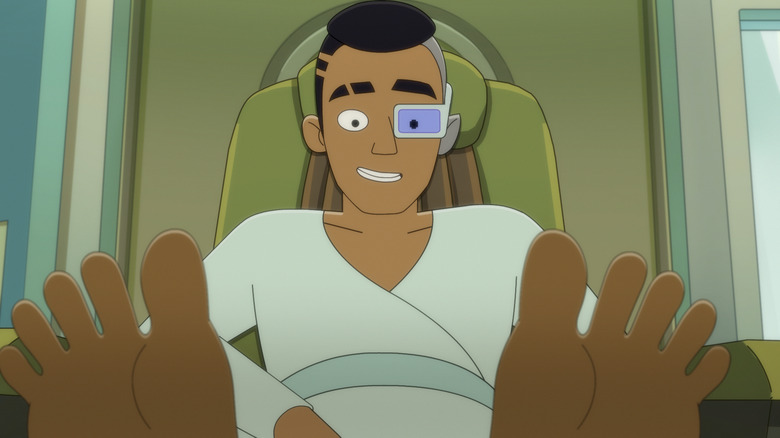
The fifth episode of the third season of "Star Trek: Lower Decks," called "Reflections," delves deeper into a few intriguing mysteries surrounding the cranial implants sported by Ensign Rutherford (Eugene Cordero). Rutherford has previously stated that his implants were voluntarily added to his body as a way to merely enhance his brain and senses. In previous episodes, however, the implants have revealed the ability to tinker with his brain functions. Not only can Rutherford selectively erase memories, but the implant also seems to alter his personality.
In "Reflections," it is revealed that Rutherford's implants are, in fact, deliberately installed as a measure to repress a version of his personality. The old Rutherford was a rebellious foulmouth who hated most everything. The new Rutherford is mild-mannered and gentle and obedient. "Reflections" eventually finds both Rutherfords fighting for dominance in a simulated brainscape where the two sides of the character can interact. Unusual for "Lower Decks," this part of the story is presented completely straight and without levity.
The "two sides facing off" story is, of course, old hat for "Star Trek," and there have been multiple episodes across the franchise that have featured characters struggling with a dark doppelgänger. And while that conceit might leave one assuming myriad spy plots and thriller-like stories, on "Trek," doppelgänger stories are more typically used for meaningful character analysis. Our own darkness, in "Star Trek," is a vital part of who we are. We are yin and yang and they are not separate.
When Doppelgängers Meet

The first example of a doppelgänger episode in "Star Trek" is the original series episode "The Enemy Within" (October 6, 1966). In that episode, Captain Kirk (William Shatner) was bifurcated thanks to a transporter malfunction, with his aggressive side and his gentler sides now living as separate entities. While the aggressive "evil" Kirk is certainly a problem aboard the ship, it's also stated that Kirk actually requires both aggression and compassion to be an effective leader. The two Kirks are reconstituted.
Other Trek doppelgängers include Lore (Brent Spiner) who is, more or less, Data's evil twin. William Riker (Jonathan Frakes) was once accidentally bifurcated by a transporter, creating a double who was stranded on an inhospitable planet for many years. The duplicate eventually changed his name to Thomas. Jean-Luc Picard (Patrick Stewart) met his own time-shifted double in the episode "Time Squared," and met a younger, evil clone of himself (Tom Hardy) in "Star Trek: Nemesis."
More positively, on the "Star Trek: Deep Space Nine" episode "Facets" (June 12, 1995), Jadzia Dax (Terry Farrell) was able to use psychic means to separate out her various lifetimes into the bodies of her crewmates (her species lives symbiotically with long-lived implanted worms that bond with a series of host bodies). On the "Star Trek: Voyager" episode "Faces" (May 8, 1995), B'Elanna Torres (Roxann Dawson), is medically separated by a Vidiian into two bodies, one human and one Klingon. Even "Lower Decks" already features a second Brad Boimler (Jack Quaid). And none of this is to mention the notorious Mirror Universe, where everyone has an evil twin.
In most instances, each character is forced to confront or explore something they don't like or haven't acknowledged about themselves
Things Are Deepening

"Lower Decks" is a comedy show, but has, by including a doppelgänger episode, skewed gently to the dramatic. The tone of the episode overall is still light and, thanks to the episode's B-plot at a Starfleet recruiting booth, the levity is still high. But Rutherford, viewers may find, is far richer and more complex than his usual upbeat attitude would belie. "Lower Decks" has been incredibly deft in its ability to introduce characters as broad or simple, and then spend a few episodes slowly pushing them toward a more recognizable humanity.
This is a pattern that holds true for the series itself. The first episode of "Lower Decks" was crass and shrill. By episode three, it latched on to something solid and funny and sweet. Now, but the third season, "Lower Decks" has created a mythology all its own, and characters with quirks and foibles beyond a few basic descriptors. Mariner, previously an agent of chaos, is showing that her spiky personality can get her in trouble, and that, despite everything, she can still fall in love. Boimler, while still a neurotic careerist, has proven himself capable of displaying confidence. Ensign Tendi (Noël Wells) is emerging as more ambitious than her gentle demeanor previously suggested. And Rutherford, it has now been revealed, has a dark past he must rediscover.
While Rutherford's conflict with his own dark past is staged as an action-packed psychic starship race, there is a certain identity crisis at play. Who is Rutherford, really? Is he the constructed personality implanted by his cybernatic brain, or is he still the caustic man he used to be? Part of Rutherford seems to prefer the former, meaning he'll constantly be in conflict with the latter.
This is good "Star Trek" stuff.
Read this next: The Strongest Star Trek Villains Ranked
The post Star Trek: Lower Decks Season 3 Uses a Classic Trek Trope to Tell Its Most Meaningful Story Yet appeared first on /Film.
from /Film https://ift.tt/YBT3eaD






0 Comments
Please don't use vulgar comments and avoid discussion on Religious matters